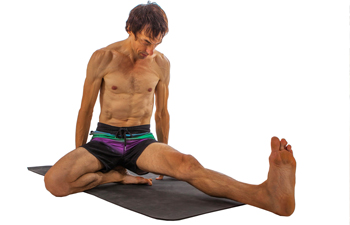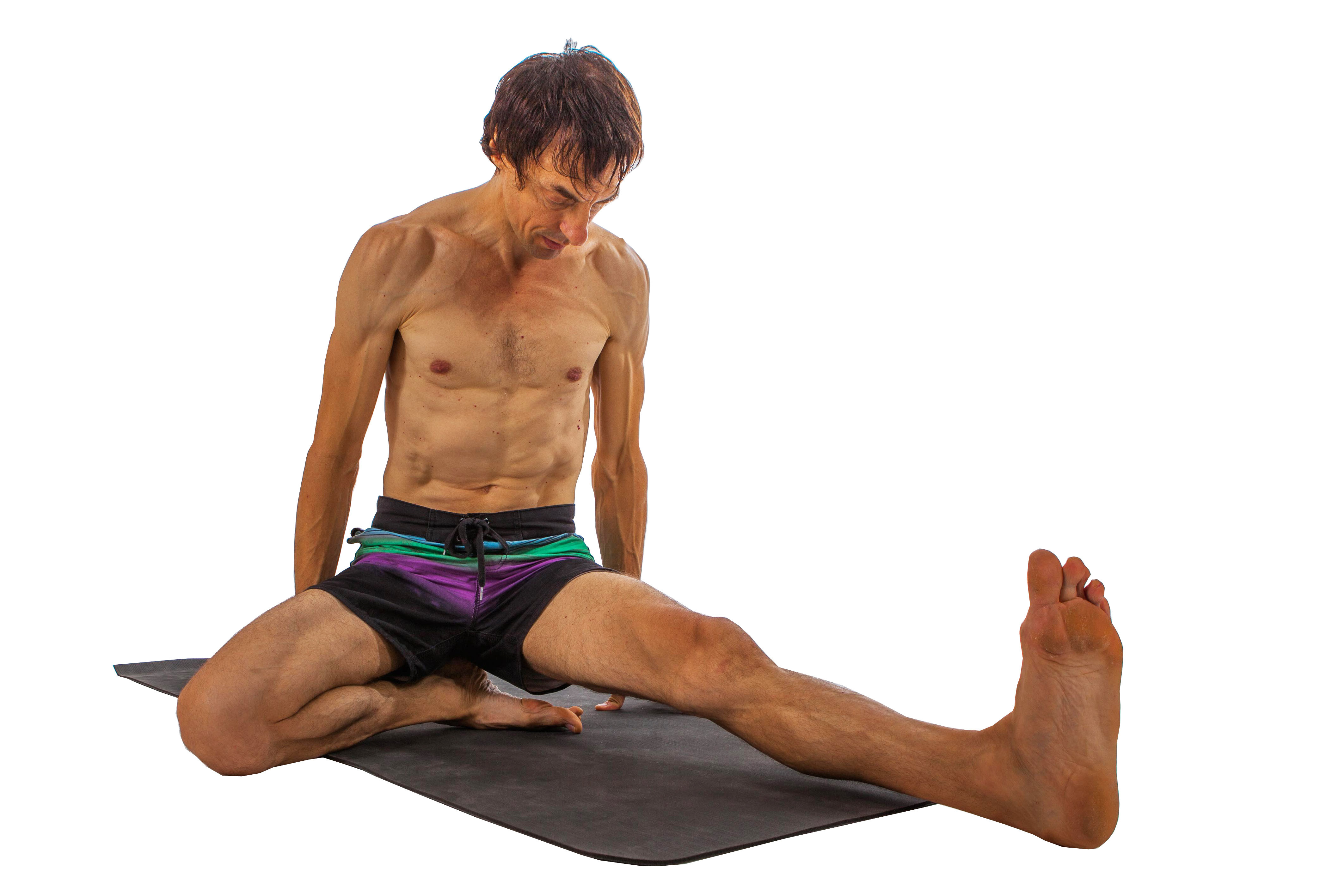
Through the practice of mula bandha you set up the conditions for accessing the contents of your mind. Placing your awareness within your pelvis you cultivate the experience of the perineal space as the source of immovable asanas, subtle inward discernment, and sacred internal worship and communion. And paradoxically to access the imaginal, psychological, emotional, and unconscious parts of your psyche, you work in a decidedly physical manner with asanas and pranayama; curiously orienting your awareness, posture, and movement from within a tiny area inside your pelvis.
The energetic aspect of practicing mula bandha is to seal in your prana in order to withdraw inward so that prana shakti can awaken at the base and enter the tiny middle channel, the glorious, central, vertical conduit. Closing in your prana can be psychologically viewed as an alchemical closing of the vessel, as a decision to create an internal and psychological view of yourself, as a place of contemplation, abidance, analyzation, reflection, healing, and realization through inner awareness where you experience and investigate the contents of your mind.

The psychic vessel that you create within yourself with the help of mula bandha can give you an animated, slowed-down view of your mind and teach you to observe the psychic contents that present themselves to you without bias or interference. Purifying and concentrating the mind is partly a matter of carefully observing your thoughts, moods, reactions, and emotions. Practice teaches you to struggle with yourself enough to allow this investigative observation to happen routinely. The eventual goal is to allow your mental contents to arise and settle freely without you grabbing onto or pushing away anything. To do this you can envision a larger container for your thoughts, a hermetically sealed psychic vessel that embraces the contents of your mind as naturally as the sky receives the comings and goings of clouds, rain, wind, storms, and the daily, cyclical, magnificently colored sacred arcing journeys of the sun and moon.
But it is essential to appreciate the extent of the challenge it is to live in a perpetual state of samadhi, of perfectly aligned attention; to imitate the sky with your mind and live in continual awareness of the large background; to see the relativity of thought, the ever-changing nature of thought, from the unbiased, large overview; to be in continual equanimity, a state of mental purity, maturity, and lucidity. Painful mental or physical disturbances arise when you lose the wide, sky-like mental orientation, when you narrow your mind, when you clamp down on certain mental contents, when you create obstructions and hold onto certain contents. This can happen suddenly, swiftly, and unconsciously as you are swept away in a flash and carried off into a preset reaction: a well-grooved, often-traveled thinking or behavioral chain that leads to a well-known painful end. Allowing yourself to be triggered into these conditioned responses, to sensations from the senses, allows your mind to rule over you as a petty tyrant, a brutal dictator who knows how to keep you in place.
When you can look within yourself with uncolored, discerning senses, free of desire, you can realize the grandeur of no mind, the vast, sky quality of consciousness, the pure, reflective capacity of a subtle mind, the invisible, unknowable background, and support to small, ordinary thought.
Deciding to make a serious study of mula bandha can be challenging because of the delicacy of musculature in this area. Perhaps even moreso because there can be a sensitivity in working with the pelvic, genital, and anal areas of the body. I sometimes think of the lower pelvic region as an uncharted dark forest, a wild area, a potential source of fear and tension, a psychologically dangerous and taboo area.

The pelvis houses your sexual energy and the energy behind the fight or flight urge to survive. In their unchecked raw forms these energies have incredible strength and power. It could be said that the way you learn to utilize these energies within you plays a significant role in determining whether you become a fulfilled, creative, well-adjusted person or not. Your sexual energies and/or your emotional energies can become blocked, suppressed, repressed, or expressed without proper control or reflection, and thus cause pain for you and others. Mula bandha is the technique by which you make it a practice to consciously know, harness, and direct the sexual and emotional drives within your core. You endeavor to eliminate the destructive, ego-centered behaviors that these energies can evoke if they remain unconscious, unreflected upon, or carelessly unchecked.
The practice of mula bandha gives you a new and different means of sealing in the energetic life forces within your body so that you can investigate and enter into a relationship with them. You can know how you feel in your loins and guts about all things that enter into your world—people, places, experiences. And instead of blind or instinctual, reaction you learn to make careful choices based on self-reflection and analysis. You decide how or whether to express or check the energy behind your feelings. You must know and interact with your powerful emotional drives to establish a strong basis for emotional health and stability, and to find a soulful means of personal creative expression. You attain yoga, self-knowledge, in part by learning how to trust, respond to and express your feelings and your sexuality.
Mula bandha teaches you not to fear the forces and energies within you, not to be a helpless victim of the energy that drives your unconscious depths. It teaches you to let go of shame and guilt around your sexuality, anger, and envy, and to respect the deep primal energies within you; to trust, harness, and celebrate the power of these drives. Yoga practice helps you learn to follow their wisdom and their dictates consciously, creatively, and constructively. Utilizing mula bandha to become emotionally and sexually mature can be the main source of freeing and harnessing your life force, prana, and attaining success in pranayama.

Using your physical practice to access your deep psychology is facilitated by imagining a change of location for your mind. Instead of thinking with your head, move energetically down and think from your center. Allow the physical experience of your feelings to resonate from a deep source within your belly. Thus discernment, movement, and awareness will come from a more sensual, intuitional, bodily place instead of a heady, intellectual place that is removed from your center.
Decisions about movement, postural alignment, or emotional reactions that come from your head have an entirely different quality than choices that originate consciously within your guts and loins. Awakening mula bandha is about allowing yourself to embody the authentic, unmasked energies within you, energies that reveal how you truly feel.
Seen in this light, you can appreciate the potency of the practice of pranayama where you endeavor to strike a single immovable seat and use your breath to churn and stir up your prana, and then harness, control, and direct it. You purposely activate your feelings, your sexuality, and all the deepest, most powerful energetic forces within you. You endeavor to put all of your prana into circulation, to light up the entire network of energetic circuitry within you. You use the sword of discrimination to scan through the full extent of your inner-world lighting—even the most stubbornly dark, unconscious energies. Accepting and transforming such unlit, obstructed areas is one major theme in practice. Such obstructions can be physical, psychological, emotional, or behavioral. They can be resistant to direction, and automatically flow in certain fixed ways, or remain stubbornly stuck and unmovable.
By helping you clean through and free the energy that flows in the nadis, your yoga practice helps you make a complete investigation. You look within with full courage. Your passion is to know and see everything that is within you with an eye toward love, acceptance, compassion, mercy, and joy. By sincerely practicing the eight limbs you are perfected; you come into right relationship with yourself. Practice helps you find an ongoing, sacred, messy inward celebration that smiles upon and lessens your flaws, failures, crookedness, and ignorance. You give up fear, and you trust that through grace and effort you will come to self-knowledge and self-love in your own way and on your own terms. Apply yourself to mula bandha during kumbhaka and fully embrace your shakti, the energy of your depths.
Article from David's book, Vayu Siddhi: Secrets of Yogic Breathing
Comments
No comments.